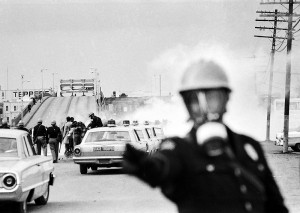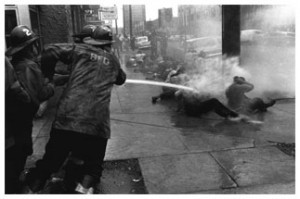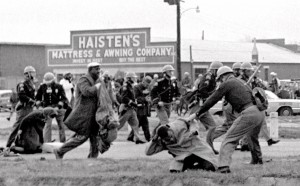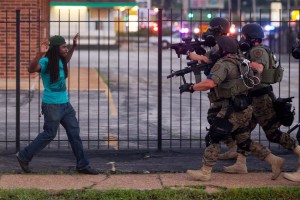Selma, “Bloody Sunday,” and the Most Important TV Newsfilm of the 20th Century
 It’s the most consequential TV newsfilm of the 20th century. The beating of voting rights marchers on the Edmund Pettus Bridge in Selma, Alabama on March 7, 1965 led directly to the passage of the landmark Voting Rights Act five months later. With the 50th anniversary commemorations of “Bloody Sunday” this past weekend, both network and cable news channels have replayed that footage over and over. But what’s its history? And why was this particular piece of television newsfilm so powerful that it managed to galvanize a nation?
It’s the most consequential TV newsfilm of the 20th century. The beating of voting rights marchers on the Edmund Pettus Bridge in Selma, Alabama on March 7, 1965 led directly to the passage of the landmark Voting Rights Act five months later. With the 50th anniversary commemorations of “Bloody Sunday” this past weekend, both network and cable news channels have replayed that footage over and over. But what’s its history? And why was this particular piece of television newsfilm so powerful that it managed to galvanize a nation?
If you go by Ava DuVernay’s masterful Hollywood film retelling of the story in Selma, you’d think that people across the country turned on their TVs that Sunday afternoon and saw live, breaking coverage of the beating and gassing of marchers by Alabama state troopers as it was happening. Of course that couldn’t – and didn’t – happen. In a pre-satellite era, direct-to-air broadcast from news hot spots typically wasn’t possible. Americans did not see live coverage from the Edmund Pettus Bridge. What did happen was actually more significant and helps to explain precisely why the newsfilm, when it was broadcast, had such an impact.
ABC was the third-run network in 1965 but on Sunday nights, it had a ratings hit with its prime-time “Sunday Night at the Movies.” And on March 7th it was expecting especially large audiences for the TV premier showing of Stanley Kramer’s 1961 blockbuster, Judgment at Nuremburg. With an all-star cast, it examined German moral culpability for the Holocaust. An estimated 48 millions viewers (more than would typically watch the evening news and far more than would watch prime-time news documentaries) were settled in when ABC’s news division abruptly broke in to the movie with a report about the attack on the Pettus Bridge.
This may not have been Raymond Williams’ “planned flow,” but the transfer of meanings from the one text to the other certainly amplified, sharpened, and made more poignant the brutality in the Selma footage. As I discuss in my book Equal Time: Television and the Civil Rights Movement, many commentators and ordinary people made the logical connections between Nazi storm troopers and Alabama state troopers. Had the Bloody Sunday report merely been a story in the following Monday’s evening news, it likely would not have had the resonance it achieved by being placed in prime time – especially prime-time Sunday, then and now the most watched night of the week. That the footage was juxtaposed to a narrative about Nazi brutality to victimized Jews made already frightful footage even more shocking.


The imagery of victimization is also crucial to how and why the Bloody Sunday newsfilm moved audiences the way it did in 1965 and continues to do so 50 years later. In his examination of civil rights era news photography, Martin A. Berger in his book Seeing Through Race, argues that the images that have come to represent the civil rights movement typically give us activated whites and powerless, subjugated blacks who are meant to serve as objects of white pity. Look at this iconic photograph from the 1963 Birmingham campaign (pictured above, top): the white firemen are in charge as they brutalize helpless blacks prone on the ground. Likewise, the Bloody Sunday footage (pictured above, bottom) gives us blacks knocked over and sprawled to the ground as the state troopers plow over them. The ultimate message is that whites are always in control and that good white people, seeing these images, need to take control away from bad white people to ameliorate the condition of victimized but powerless black people. Berger criticizes this impulse in civil rights iconography as it discounts the agency of African Americans; its short term benefits (passage of legislation) undermines attention to more long term structural issues around racism and white supremacy.
Berger’s argument is compelling but it does discount the agency among civil rights activists in orchestrating these confrontations. During the Selma campaign, Dr. Martin Luther King, Jr. publicly proclaimed, “We are here to say to the white men that we no longer will let them use clubs on us in the dark corners. We’re going to make them do it in the glaring light of television.” Rather than hapless, docile, pathetically suffering objects, civil rights activists knowingly embraced the redemptiveness of unmerited suffering (as King put it) and the iconography of white violence. They were active agents in these narratives, whether or not white audiences grasped that fact or not. Ironically, the white racists were less in charge than they may have thought. On Bloody Sunday, probably none of the marchers expected they were heading to Montgomery that day. Marching to Montgomery wasn’t the narrative. Segregationist oppression and obstruction was the story the marchers expected to tell. None of those marchers, however, expected to degree of the brutality they encountered. And that’s why the footage is so shocking: the white violence is so out-of-control, so excessive.
 The sheer hyperbolic, disproportionate response of white power at the Edmund Pettus Bridge calls to mind another set of images that galvanized the attention of the nation a lot more recently: Ferguson (pictured left). This is one of the iconic images of the August 2014 confrontations between the militarized Ferguson police force against the unarmed mostly black Ferguson citizens protesting the police killing of an unarmed young black man. The now-famous “hands-up, don’t-shoot” stance by the protesters suggests victimization and a docile subjugation. But, of course, it’s anything but. The Ferguson protesters empowered themselves and their community, eventually leading to the recent action by the Department of Justice, in part by the dissemination of media imagery that suggested powerlessness. In the end, the protesters commanded far more power than the police with their 2014 body armour and Humvees or the 1965 troopers with their billy clubs and tear gas. In both cases, they made the federal government take action. In both cases, they understood the power of media imagery to tell narratives that at key moments they controlled.
The sheer hyperbolic, disproportionate response of white power at the Edmund Pettus Bridge calls to mind another set of images that galvanized the attention of the nation a lot more recently: Ferguson (pictured left). This is one of the iconic images of the August 2014 confrontations between the militarized Ferguson police force against the unarmed mostly black Ferguson citizens protesting the police killing of an unarmed young black man. The now-famous “hands-up, don’t-shoot” stance by the protesters suggests victimization and a docile subjugation. But, of course, it’s anything but. The Ferguson protesters empowered themselves and their community, eventually leading to the recent action by the Department of Justice, in part by the dissemination of media imagery that suggested powerlessness. In the end, the protesters commanded far more power than the police with their 2014 body armour and Humvees or the 1965 troopers with their billy clubs and tear gas. In both cases, they made the federal government take action. In both cases, they understood the power of media imagery to tell narratives that at key moments they controlled.



[…] /2015/03/10/selma-bloody-sunday-and-the-most-important-tv-newsfilm-of-t… […]